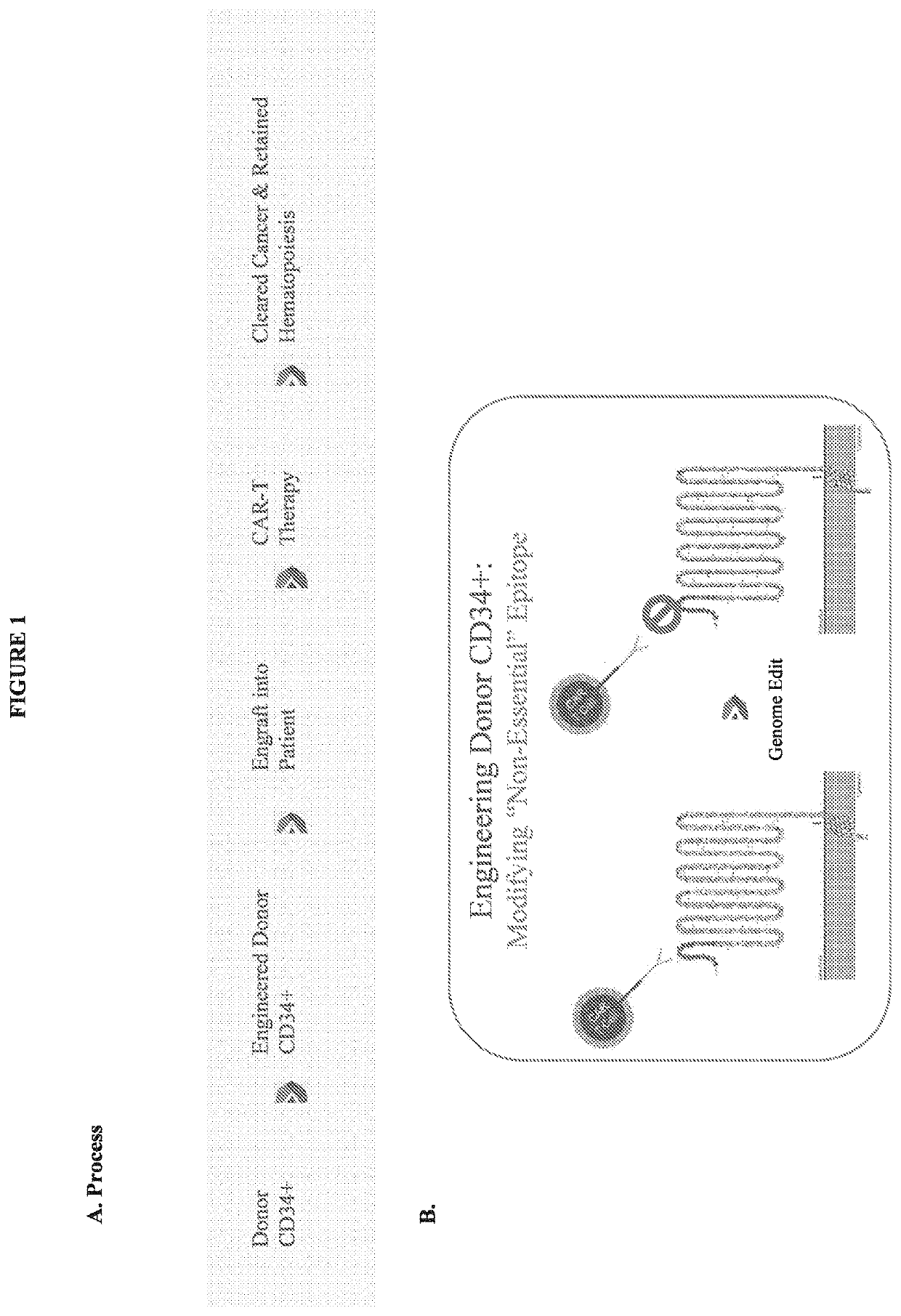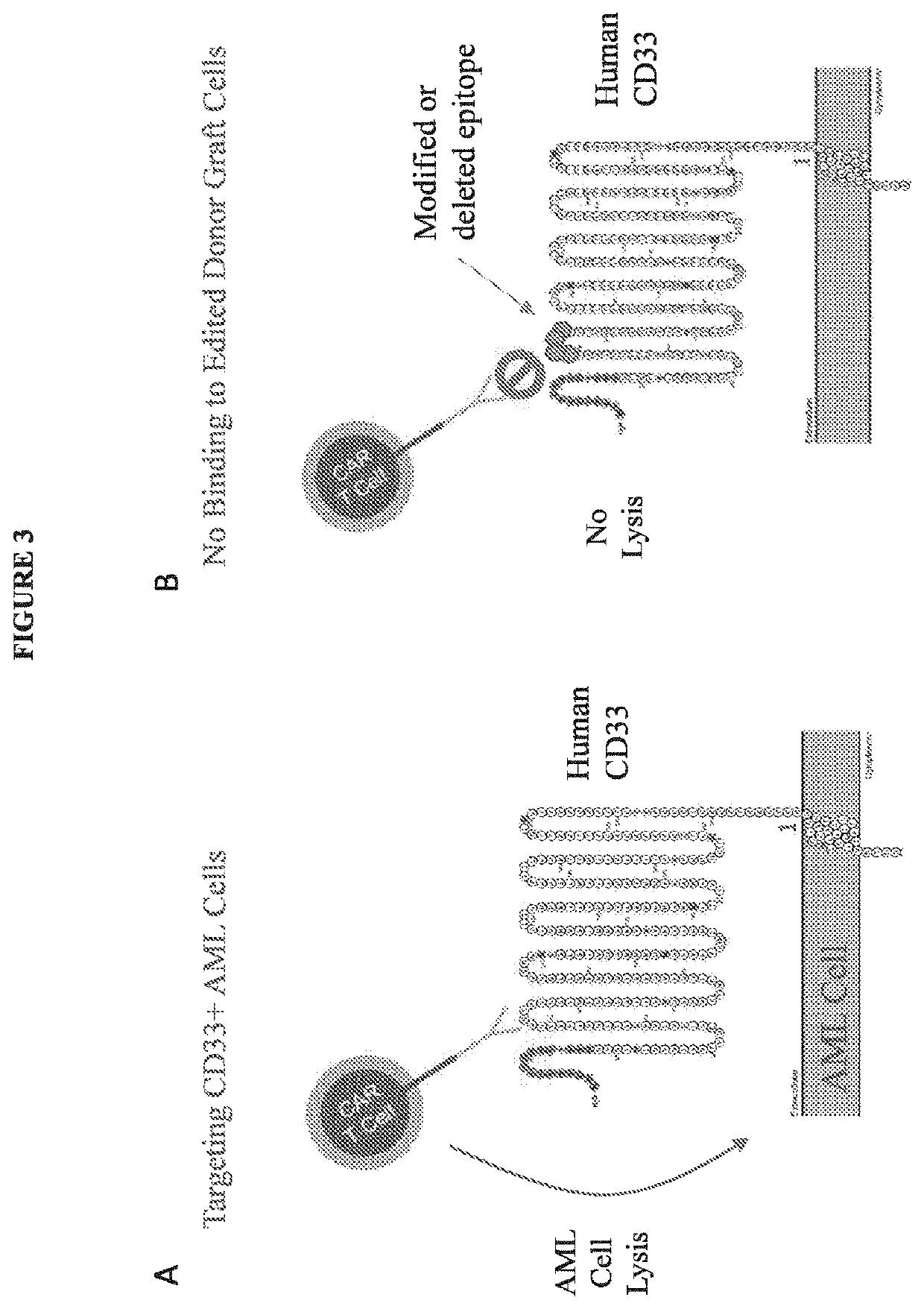Compositions and methods for inhibition of lineage specific proteins
a technology of specific proteins and compounds, applied in the direction of immunoglobulins, peptides, drugs against animals/humans, etc., can solve the problems of limited use of such therapies, normal cells unharmed, effective targeting of cancer cells, etc., and achieve safe and effective treatment and reduce the binding of cytotoxic agents
- Summary
- Abstract
- Description
- Claims
- Application Information
AI Technical Summary
Benefits of technology
Problems solved by technology
Method used
Image
Examples
example i
ation and Mutation of Epitopes in CD33 Expressed in Hematopoietic Cells
[0217]Using human CD33 as an exemplary lineage-specific cell-surface antigen, regions of the protein in which mutation and / or deletion of amino acids are less likely to result in deleterious effects (e.g., a reduction or abrogation of function) were predicted using PROVEAN software (see: provean.jcvi.org; Choi et al. PLoS ONE (2012) 7(10): e46688). Examples of the predicted regions are shown in boxes in FIG. 2 and exemplary deletions in the predicated regions are presented in Table 2. Numbering of the amino acid residues is based on the amino acid sequence of human CD33 provided by SEQ ID NO: 1.
TABLE 2Exemplary deletions in CD33PROVEANEpitope targeted DeletionScoreby cytotoxic agentS248-E252-5.508SGKQE (SEQ ID NO: 8)I47-D51-5.661IPYYD (SEQ ID NO: 9)G249-T253-7.078GKQET (SEQ ID NO: 10)K250-R254-7.184KQETR (SEQ ID NO: 11)P48-K52-7.239PYYDK (SEQ ID NO: 12)Q251-A255-7.888QETRA (SEQ ID NO: 13)
[0218]The nucleotide sequ...
example 2
n and Characterization of Cells
[0226]Primary human CD8+ T cells are isolated from patients' peripheral blood by immunomagnetic separation (Miltenyi Biotec). T cells are cultured and stimulated with anti-CD3 and anti-CD28 mAbs-coated beads (Invitrogen) as previously described (Levine et al., J. Immunol. (1997) 159(12):5921).
[0227]Chimeric receptors that bind to an epitope of CD33 are generated using conventional recombinant DNA technologies and inserted into a lentiviral vector. The vectors containing the chimeric receptors are used to generate lentiviral particles, which are used to transduce primary CD8+ T cells. Human recombinant IL-2 may be added every other day (50 IU / mL). T cells are cultured for ˜14 days after stimulation. Expression of the chimeric receptors can be confirmed using methods, such as Western blotting and flow cytometry.
[0228]T cells expressing the chimeric receptors are selected and assessed for their ability to bind CD33 and to induce cytotoxicity of cells expr...
example 3
[0230]An example treatment regimen using the methods, cells, and agents described herein for acute myeloid leukemia is provided below.
[0231]1) Identify a patient with AML that is a candidate for receiving a hematopoietic cell transplant (HCT);
[0232]2) Identify a HCT donor with matched HLA haplotypes, using standard methods and techniques;
[0233]3) Extract the bone marrow from the donor;
[0234]4) Genetically manipulate the donor bone marrow cells ex vivo. Briefly, introduce a targeted modification (deletion, substitution) of an epitope of the lineage-specific cell-surface protein. In general, the epitope should generally be at least 3 amino acids (e.g., about 6-10 amino acids). Genetic modification of this epitope of the targeted lineage-specific cell-surface protein on the donor bone marrow cells should not substantially impact the function of the protein, and as a consequence, should not substantially impact the function of the bone marrow cells, including their...
PUM
| Property | Measurement | Unit |
|---|---|---|
| Volume | aaaaa | aaaaa |
| Volume | aaaaa | aaaaa |
| Volume | aaaaa | aaaaa |
Abstract
Description
Claims
Application Information
 Login to View More
Login to View More - R&D
- Intellectual Property
- Life Sciences
- Materials
- Tech Scout
- Unparalleled Data Quality
- Higher Quality Content
- 60% Fewer Hallucinations
Browse by: Latest US Patents, China's latest patents, Technical Efficacy Thesaurus, Application Domain, Technology Topic, Popular Technical Reports.
© 2025 PatSnap. All rights reserved.Legal|Privacy policy|Modern Slavery Act Transparency Statement|Sitemap|About US| Contact US: help@patsnap.com



